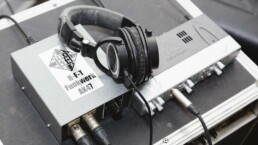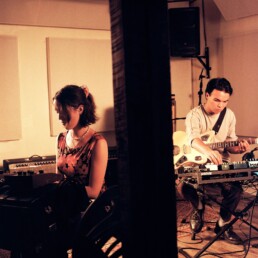What Should A Studio Be in 2023?
Michael Hahn
Owner and Senior Engineer at Autoland. Editor at the LANDR Blog. One third of swirling indie rock trio Slight.
Music lives in cities, but it’s harder than ever to find urban spaces suitable for making it.
The best music spaces play an active role in the creative process for artists.
From bedrooms to bars and DIY lofts, the environments where music is made and heard matter.
For it to work, good creative spaces have to be flexible and resilient to stay effective as the industry evolves.
Meeting the challenge is especially important for studios and music communities struggling against today’s highly stratified, pandemic-ravaged music world.
With that in mind, here’s everything a studio needs to be to work for modern musicians.
1. Affordable and accessible
Musicians have never struggled more to participate in their own industry.
With the professional tier of artists concentrated in the top 1%, the idea of an artistic middle class is essentially over for musicians.
If you make music today, you’re likely doing it independently—without the kind of budget that used to help drive local music economies.
It’s the reason why dozens of large scale studios are closing their doors or downsizing dramatically.
The high day rates needed to keep the lights on at these large facilities simply aren’t sustainable.
Any modern music space needs to make affordability and access its top priority to support artistic development.
Progressive pricing models, low base rates and shared resources are the only way to provide a high-quality experience without excessive cost.
2. Better than your bedroom
DIY music production is getting more capable with every new product cycle.
But there are still clear limits on the possibilities and outcomes of bedroom recording.
Purpose-built music spaces need to address them directly and provide the best possible resources for artists to break through barriers.
The right studio conditions are essential to make it happen.
Music lives in cities, but it’s harder than ever to find urban spaces suitable for making it.
It’s the reason why bedroom production tools focus on in-the-box alternatives to traditionally loud or bulky processes.
Unfortunately, few traditional recording practices can be done 100% in-the-box without compromise.
Software emulations help close the gap, but music that requires live playing and loud sound can’t be done well in an apartment.
In fact, the key factor for getting better results than bedroom studios is the recording environment itself.
That means an effective studio has to be completely free of the constraints on home recording that come with an urban environment. I’m talking about noise complaints, neighbours, roommates and shared spaces.
Effective studios need to provide space that alleviates those concerns and helps creators make the most of the opportunity.
Not only that, purpose-built music spaces need to address the basic functional issues that stack the deck against home recording.
Acoustic treatment, separate tracking and monitoring environments and patching flexibility are a must.

Sessions that start in the studio need to migrate easily to home mixing rooms. Bedroom demos should be simple to build on in the studio.
3. Flexible for any workflow
It’s been decades since music production followed a predictable workflow pattern.
The techniques used in different genres vary so greatly that most producers’ approaches don’t overlap.
But if there’s any common thread, it’s that artists and producers need to bring their work with them across multiple working environments.
Modern studio spaces need to tackle a huge variety of production styles and allow creators to work on their projects from anywhere.
Sessions that start in the studio need to migrate easily to home mixing rooms. Bedroom demos should be simple to build on in the studio. Projects recorded in multiple locations shouldn’t require extensive tinkering to pull up on the monitors.
The only way to make it happen is to commit to a hybrid workflow that offers pro studio flexibility without abandoning home studio compatibility.
It means augmenting the basic audio interface production paradigm with analog patchability, hardware DSP, multi-DAW compatibility and pro sound quality.
Forget about pulling up an Ableton Live session in studios based around large-format analog consoles or expansive Pro Tools HD rigs.
In a hybrid environment, you can use anything you want on the software side and get all the benefits of a pro studio.
I’m talking about perks like superior conversion and monitoring, character preamps
higher input channel count and DSP routing.
This is studio functionality that helps you in the moment but doesn’t make it harder down the line.

4. Well-equipped and organized
A modern music space can only be successful if its resources are effective, well-maintained and immediately accessible for use.
Most large-scale facilities still in operation today don’t have the budget to maintain their entire gear inventory to a usable standard.
Even flagship equipment like consoles and vintage mics (that supposedly justify the high studio fees) may not be maintained to modern standards of headroom or noise performance.
Add to that the difficulty of actually configuring sessions to use this equipment and you get an experience that rarely feels worth it when the clock is ticking on paid time.
A modern recording environment simply should not waste resources on this type of equipment—and certainly should never pass the high cost on to clients.
Smaller, hybrid studios can stay laser-focused on fast and flexible access to quality tools that make a discernible difference to the end result.
After all, do your clients really choose where to work based on gear lists alone? Hardly ever.
It’s much more important to provide equipment that balances useability with sound quality and doesn’t take a specialist to operate.
Recording at a traditional large-scale studio is a rare privilege for most musicians. Booking one for pre-production or rehearsal sessions is almost unheard of.
5. Connected to a community
Artists don’t create their work in a vacuum.
Creative environments need to be meeting places where people and ideas can interact.
A studio can take on these qualities, but not if musicians can’t afford to participate.
Meaningful connections require regular access over time for a larger, more diverse group of collaborators.
Without industry support, it’s not practical to create that experience in a traditional studio environment.
Instead, multi-use spaces that support music creation at every stage naturally foster a broader range of roles.
Artists, musicians, producers, engineers and other collaborators are more likely to cross-pollinate in spaces that don’t rely solely on daily bookings of a single activity.
To give an example, recording at a traditional large-scale studio is a rare privilege for most musicians. Booking one for pre-production or rehearsal sessions is almost unheard of.
But these activities become possible when cost barriers are removed.
In the end, a well-organized, smaller facility can provide many of the same essential functions as a larger one, while also contributing to many others that help nurture the creative process.
The next generation of music spaces
These five issues are the most frustrating obstacles I experienced over a decade of producing music for myself and others on shoestring budgets.
They’re also the most pressing problems I knew I needed to tackle when I opened my own studio in the Montreal area.
After our first few years in operation, I’m confident that we’ve made progress on almost all of them.
If you’re facing setbacks related to any of the points I raised above, I invite you to come join us, or at least learn more about Autoland to find out how you can get involved.
